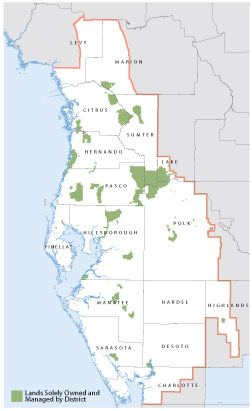Parcels With No Water Resource Benefits May Be Offered for Sale

The District is hoping to increase efficiencies and save taxpayer dollars by returning surplus parcels of land to the private sector.
The Governing Board asked staff members to assess the District’s land holdings, looking for properties that may not be needed. The District protects more than 436,000 acres of land within its boundaries. District lands include natural floodplains, aquifer recharge areas and areas around lakes, rivers, wetlands and estuaries.
According to Roy Mazur, District Operations Bureau chief, land won’t be considered surplus if it is still needed.
“Land may be considered surplus if it no longer meets the original acquisition purpose or doesn’t provide water resource benefits,” said Mazur. Such benefits include flood control, aquifer recharge, water storage, water management, water resources conservation and protection, water resource and water supply development, and wetland, stream and lake preservation.
Finding lands that are surplus and eligible for sale is a new task for District staff members, but they are getting help from the Suwannee River Water Management District in northern Florida. The Suwannee district already has a surplus lands program in place and this District is using Suwannee’s successful program as a model.
The Governing Board appointed a Surplus Lands Subcommittee to help staff build an evaluation process that is open to the public. Planners will begin by looking at about 261,000 acres that are solely owned and managed by the District, starting in the District’s southern region.
District land may now be considered surplus because the project it was purchased for has been completed. Other parcels may have been part of a larger buy.
“Most of the District’s land purchases were voluntary,” said Mazur. “In some cases landowners were unwilling to divide the property they offered for sale, so some of our purchases of environmentally sensitive lands included portions that had little conservation value.”
Staff will be looking at a number of criteria to identify surplus parcels. Lands will be judged first for their water resource value: for floodplain management and the protection of surface waters, wetlands, springs and aquifer recharge areas. Parcels that do not have high water resource value will be screened to make sure that selling them will not jeopardize the management of other District-owned lands or adjacent public holdings.
The District will hold public meetings to explain the evaluation process. The Surplus Lands Subcommittee will review staff’s recommendations and then report to the 13-member Governing Board. Ultimately, it will be up to the Board to decide which lands are surplus.
The District will seek public input throughout the process and will announce public workshops as they are scheduled. For details on the District’s surplus lands assessment, visit WaterMatters.org/SurplusLands/.
